International Toy Fair Nuremberg 2007
Internationale Spielwarenmesse Nürnberg 2007
| x |
|
|
|
|
|
|
|
|
|
|
|
|
|
|
|
|
|
|
|
|
|
|
|
|
|
|
|
|
|
|
|
|
|
 |
|
|
|
|
|
|
|
|
|
|
|
|
|
|
|
|
|
|
|
|
|
|
|
|
|
|
|
|
|
|
|
 |
|
|
|
|
|
|
|
|
|
|
|
|
|
|
|
|
|
|
|
|
|
|
|
|
|
|
|
|
|
|
|
| x |
|
|
|
|
|
|
|
|
|
|
|
|
|
|
|
|
|
|
|
|
|
|
|
|
|
|
|
|
|
|
|
|
|
Huch & Friends
|
|
|
|
|
|
|
|
|
|
|
|
|
|
|
|
|
|
|
|
|
|
|
|
The card game that Caylus now has become still has many of the familiar game components of its larger brother such as goods cubes, players cilinders and discs, and (this time cardboard) money. Gone is the game board, there is one good less in the game, and there is no privileges track anymore. The bayliff has been deleted too, and the provost always moves two spaces forward apart from being moved either way by the players. All the cards have the same back: the wellknown green building necessary to upgrade to blue buildings. All players start with an identical deck of cards in their own colour that is shuffled; three may be taken on their hand. In a turn a player may place a worker and pay 1 dinar, draw a card for 1 dinar, discard all his hand cards and draw new (1 dinar), or build one of the buildings by playing that card or build one of the advanced buildings by paying the items for it. There are less advanced buildings, only seven, and their value in victory points is reduced. This way it is quite normal to be the winner in a game with only 40 points! Building on the palace for three fixed goods (as opposed to the one food and two different others) gives a player a palace piece: victory points from an organised stock that decreases in value through the game.
|
 |
|
|
|
|
|
|
|
|
|
|
|
|
|
|
|
|
|
|
|
|
|
|
|
|
|
|
|
|
|
|
|
|
|
|
 |
|
When nobody has built on the palace, two palace pieces still are removed from play. The player who has contributed the most to the building on the palace, now gets one gold instead of a privilege. A building can give a fixed cube award, or one cube from a stock of 4 that was put on a card when erecting the building and that gets depleted. The game ends by depletion of the palace pieces, after which players count their points for various items such as having the most money or buildings erected. |
The game has been made more smoothly and will be easier to play for players new to the game. If those players need to upgrade to the 'full' board game thereafter remains to be seen, as well as it is questionable if players who already possess the latter will need the ‘card’ game. Maybe this version is what Caylus should have been in the first place.
Caylus Magna Carta, prototype, William Attia, 2-4 players, 10 years and up, 45-90 minutes |
| x |
|
|
|
|
|
|
|
|
|
|
|
|
|
|
|
|
|
|
|
|
|
|
|
|
|
|
|
|
|
|
|
|
|
|
Sherwood is a new title from Tilsit of which nothing more is known than is printed on the mock-up of the box:
Sherwood, Vlaada Chvatil, 2-5 players, 10 years and up, 60 minutes
|
|
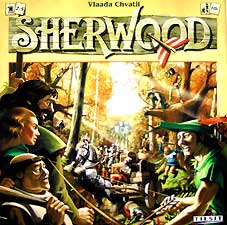 |
| x |
|
|
|
|
|
|
|
|
|
|
|
|
|
|
|
|
|
|
|
|
|
|
|
|
|
|
|
|
|
|
|
|
|
| Identity Games |
|
|
|
|
|
|
|
|
|
|
|
|
|
|
|
|
|
|
|
|
|
|
|
|
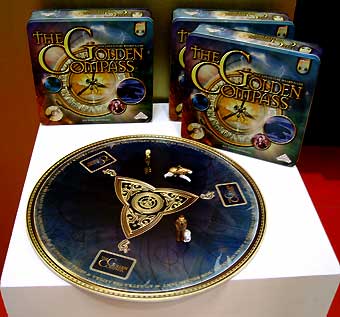 |
x |
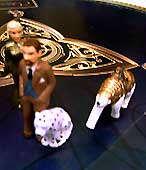 |
|
|
This years trend is taking a book and transfer it into a game, as can be seen on many publishers stands. The Golden Compass seems to be a succesfull childrens book that seems easy to transfer. Identity Games takes the story onto several changing game boards with cute painted playing figures. How it plays? Dunno.
The Golden Compass, prototype, 2-4 players, 8 years and up, 60 minutes
|
| x |
|
|
|
|
|
|
|
|
|
|
|
|
|
|
|
|
|
|
|
|
|
|
|
|
|
|
|
|
|
|
|
|
|
| Also from Identity Games comes ‘Farao’, the Dutch version of ‘Das Gold des Pharao’ published in Germany by Californian Products. |
| x |
|
|
|
|
|
|
|
|
|
|
|
|
|
|
|
|
|
|
|
|
|
|
|
|
|
|
|
|
|
|
|
|
|
| Kosmos |
|
|
|
|
|
|
|
|
|
|
|
|
|
|
|
|
|
|
|
|
|
|
|
|
|
|
|
Same story, another board game, with ‘Der Goldene Kompass’. Kosmos took a more than man high prop into their stand to seek publicity for this title. Therefore expectations will be that this game will get or seek more than normal publicity. Nothing more than a game board till now, though. And yes, another masterpiece by Michael Menzel. Michael, do you get enough sleep lately?
Der Goldene Kompass, prototype, Michael Rieneck, 2-4 players, 10 years and up, 60 minutes
|
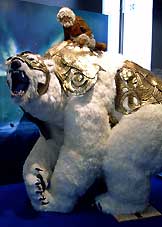 |
| x |
|
|
|
|
|
|
|
|
|
|
|
|
|
|
|
|
|
|
|
|
|
|
|
|
|
|
|
|
|
|
|
|
|
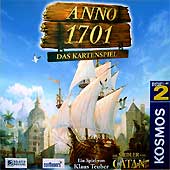 |
|
The card game 1701 (announced for 2007) of the board game 1503 (published in 2003) of the computer game 1602 (from 1998) was only present in a prototype that was hidden somewhat deeper in the stand, and thus not accessible. Only the box and some non informative blurb text was visible.
Anno 1701 - Das Kartenspiel, Klaus Teuber, 2 players, 10 years and up, 60-70 minutes |
| x |
|
|
|
|
|
|
|
|
|
|
|
|
|
|
|
|
|
|
|
|
|
|
|
|
|
|
|
|
|
|
|
|
|
|
Another 2-player game that promises to play well is ‘Sakkara’. Two players try to outrun each other in being the first to build a pyramid and top it with one of their tokens. 75 hieroglyph tiles are shuffled and randomly placed on the board, two high. The four worker tokens are also placed on the board. When taking a turn, a player must move one of his workers one tile and take the upper tile and place it on his player rack. There are some movement restrictions, but before or after his movement, a player may play any number of tiles.
|
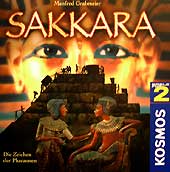 |
| x |
|
|
|
|
|
|
|
|
|
|
|
|
|
|
|
|
|
|
|
|
|
|
|
|
|
|
|
|
|
|
|
|
|
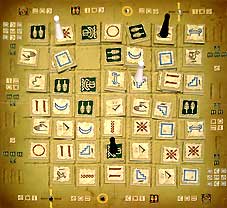 |
x |
 |
|
|
These tiles can activate different spells, can be used to help build the players pyramid, give an extra movement, steal a tile from the other player, and so on. Also there are some building requirements for the various levels of the pyramid, a maximum of 10 tiles on a players rack, and more. ‘Sakkara’, in short, seems to be a nice tactical game.
Sakkara, Manfred Grabmeier, 2 players, 10 years and up, 30-40 minutes |
| x |
|
|
|
|
|
|
|
|
|
|
|
|
|
|
|
|
|
|
|
|
|
|
|
|
|
|
|
|
|
|
|
|
|
|
Another book, another board game: ‘Tintenherz’. Curious at this game at first - after seeing the components it seems to be nothing more than a quiz-like game: ‘Mention a book beginning with a D’. Dead Souls by Gogol? Not my cup of tea as a gamer, unfortunate. Klaus Teuber lends his name on too many games nowadays, not all of them of the quality we would so very much like to see of him again.
Tintenherz, Klaus Teuber, 2-6 players, 10 years and up, 30-40 minutes
|
|
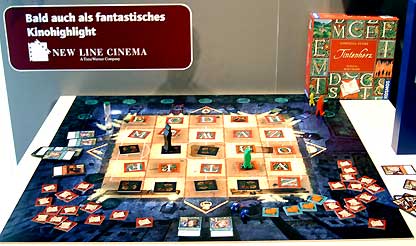 |
| x |
|
|
|
|
|
|
|
|
|
|
|
|
|
|
|
|
|
|
|
|
|
|
|
|
|
|
|
|
|
|
|
|
|
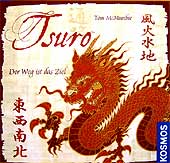 |
x |
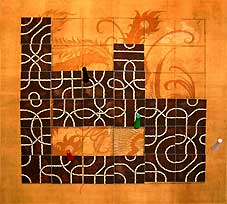 |
|
|
This nice looking game plays in only 15 minutes, but it could have an addictive element where you might play it a second time right after the first game has ended. In each turn a player has to play a tile and in doing so expanding his route in order to try to stay as long in the game as he can. A nicely produced simple game, with graphically appealing tiles but highly misleading box graphics.
Tsuro, Tom McMurchie, 2-8 players, 8 years and up, 15-20 minutes |
| x |
|
|
|
|
|
|
|
|
|
|
|
|
|
|
|
|
|
|
|
|
|
|
|
|
|
|
|
|
|
|
|
|
|
| x |
|
|
|
|
|
|
|
|
|
|
|
|
|
|
|
|
|
|
|
|
|
|
|
|
|
|
|
|
|
 |
|
|
|
|
|
|
|
|
|
|
|
|
|
|
|
|
|
|
|
|
|
|
|
|
|
|
|
|
|
|
|
 |
|
|
|
|
|
|
|
|
|
|
|
|
|
|
|
|
|
|
|
|
|
|
|
|
|
|
|
|
|
|
|
 |
|
|
|
|
|
|
|
|
|
|
|
|
|
|
|
|
|
|
|
|
|
|
|
|
|
|
|
|
|
| x |
|
|
|
|
|
|
|
|
|
|
|
|
|
|
|
|
|
|
|
|
|
|
|
|
|
|
|
|
|
|
|
|
|
 |
|
|
|
|
|
|
|
|
|
|
|
|
|
|
|
|
|
|
|
|
|
|
|
 |
|
|
|
|
|
|
|
|
|
|
|
|
|
|
|
|
|
|
|
|
|
|
|
|
|